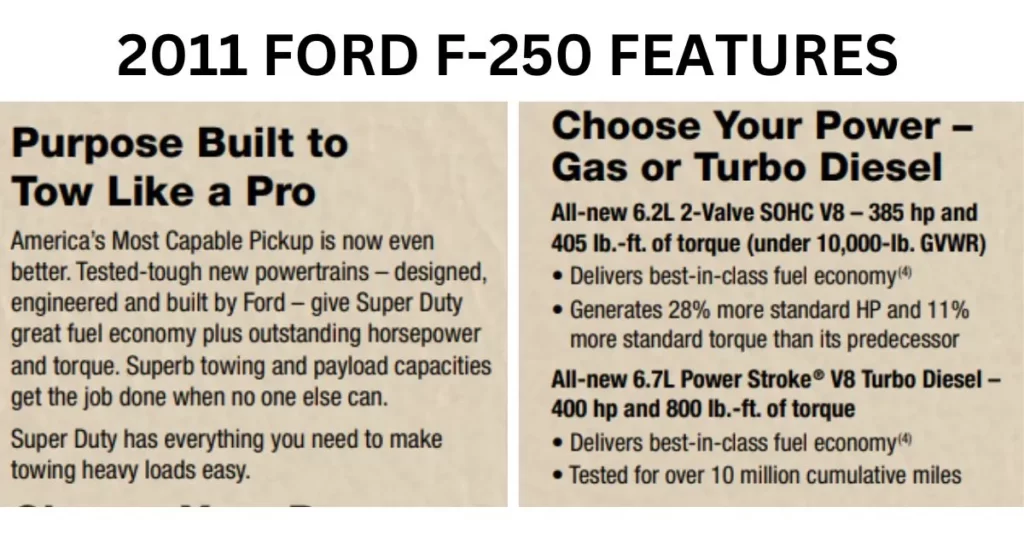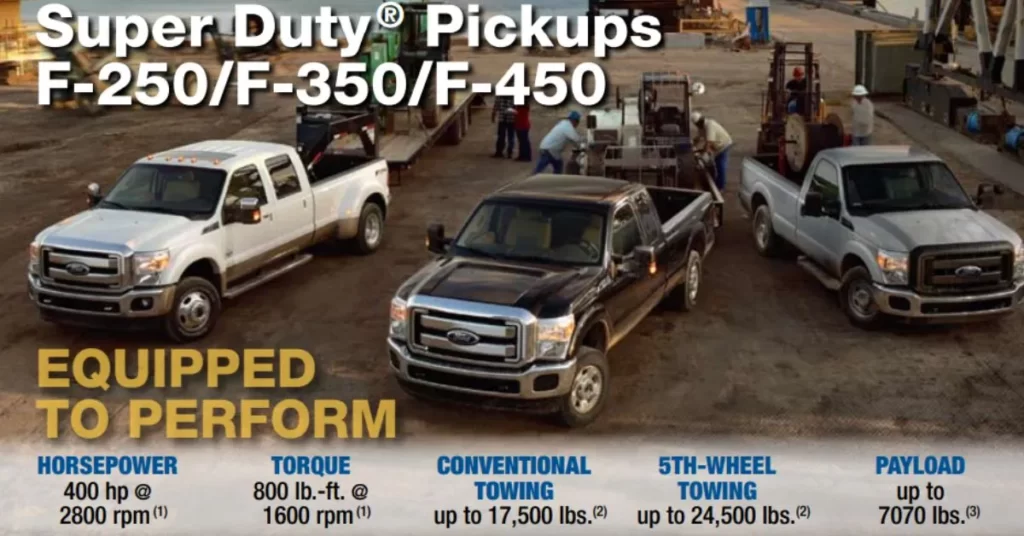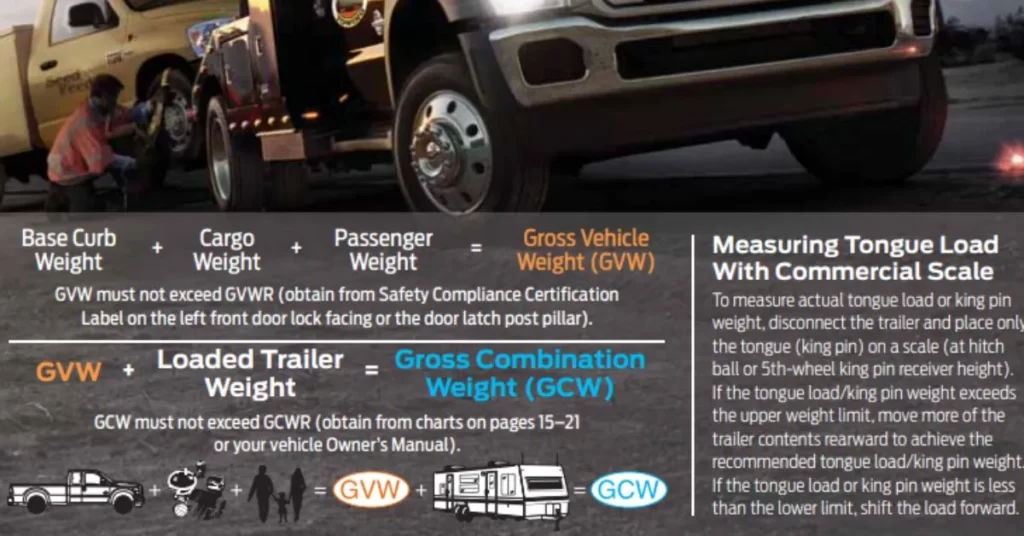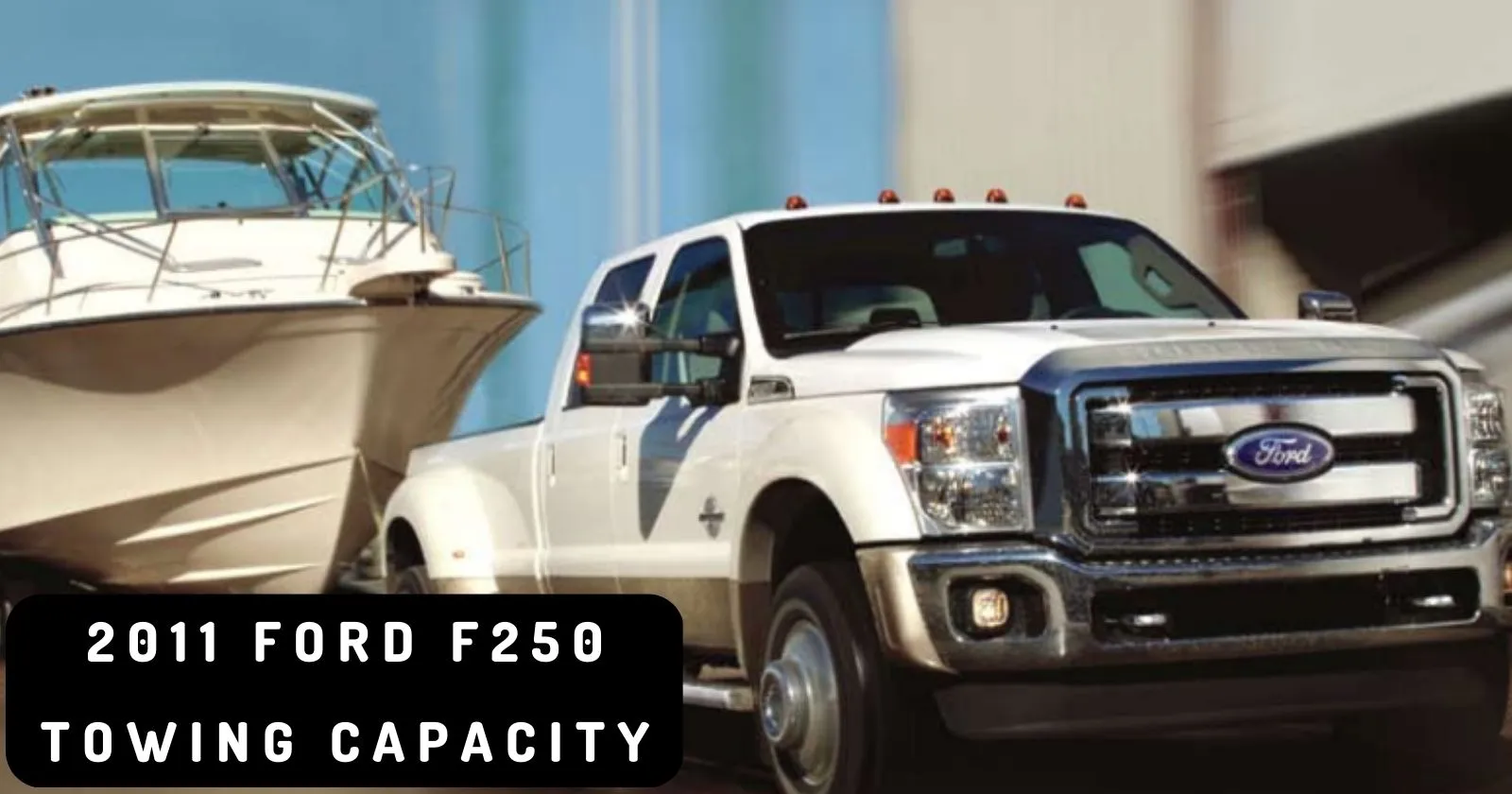The 2011 Ford Super Duty Pickups and Chassis cabs were equipped with all essential features to meet the toughest towing demands. When properly equipped, the Super Duty pickups can handle up to 17,500 lbs of conventional trailers, and 26,600 lbs of 5th-wheel trailers.
The 2011 Ford F250 was available with two powerful engines: a 6.2L 2-Valve SOHC V8, and a 6.7L Power Stroke V8 Turbo Diesel. With these powertrains, it could handle superb towing, and payload capacities.
In addition to the powerful engines, the 2011 Ford F250 Towing Capacity was supported by various towing features such as Standard Trailer Sway Control, New Standard Hill Start Assisst, Integrated Exhaust Brake, and Trailer Brake Controller (TBC).
If you own the 2011 Ford F250 or planning to purchase it soon, you can go through this detailed guide where we will discuss the 2011 Ford F250 towing capacity with engine configuration, conventional towing, 5th-wheel towing charts, and towing guidelines.
Table of Contents
2011 Ford F250 Towing Capacity [Based on Engine Type]
The two powerful engines available for the 2011 F250 were a 6.2L 2-Valve SOHC V8, and a 6.7L Power Stroke V8 Turbo Diesel Engine.

| ENGINE TYPE | MAXIMUM TOWING CAPACITY |
| 6.2L SOHC V8 Engine | 12,500 lbs (Conventional Towing) 15,800 lbs (5th Wheel Towing) |
| 6.7L Turbo Diesel V8 Engine | 14,000 lbs (Conventional Towing) 16,700 lbs (5th Wheel Towing) |
The 6.2L 2-Valve SOHC V8 engine produces a maximum power of 385 hp, and a maximum torque of 405 lb.-ft. With this powertrain, the 2011 F250 offers a maximum conventional towing of up to 12,500 lbs, and 5th-wheel/Gooseneck towing of up to 15,800 lbs.
Features of 6.2L 2-V SOHC V8 Engine
- Delivers best-in-class fuel economy
- Generates 28% more standard HP and 11% more standard torque than its predecessor
On the other hand, the powerful 6.7L Turbo Diesel V8 engine is capable of producing a peak power of 400 hp at 2,800 rpm, and a peak torque of 800 lb-ft at 1,600 rpm.
The 2011 F250 offers a maximum conventional towing of up to 14,000 lbs, and 5th-wheel/Gooseneck towing of up to 16,700 lbs.
Features of 6.7L Power Stroke V8 Turbo Diesel Engine
- Delivers best-in-class fuel economy
- Tested for over 10 million cumulative miles

2011 Ford F250 Towing Capacity Chart [Conventional Towing]

Regular Cab
| ENGINE TYPE | AXLE RATIO | GCWR | SRW 4×2 | SRW 4×4 |
|---|---|---|---|---|
| 6.2L SOHC V8 FFV | 3.73 | 19,000 lbs | 12,500 lbs | 12,400 lbs |
| 4.30 | 22,000 lbs | 12,500 lbs | 12,500 lbs | |
| 6.7L V8 Turbo Diesel | 3.31 | 23,500 lbs | 12,500 lbs | 12,500 lbs |
| 3.55 | 23,500 lbs | 12,500 lbs | 12,500 lbs |
Super Cab
| ENGINE TYPE | AXLE RATIO | GCWR | SRW 4×2 | SRW 4×4 |
| 6.2L SOHC V8 FFV | 3.73 | 19,000 lbs | 12,500 lbs | 12,200 lbs |
| 4.30 | 22,000 lbs | 12,500 lbs | 12,500 lbs | |
| 6.7L V8 Turbo Diesel | 3.31 | 23,500 lbs | 14,000 lbs | 14,000 lbs |
| 3.55 | 23,500 lbs | 14,000 lbs | 14,000 lbs |
Crew Cab
| ENGINE TYPE | AXLE RATIO | GCWR | SRW 4×2 | SRW 4×4 |
| 6.2L SOHC V8 FFV | 3.73 | 19,000 lbs | 12,400/12,300 lbs | 12,000 lbs |
| 4.30 | 22,000 lbs | 12,500 lbs | 12,500 lbs | |
| 6.7L V8 Turbo Diesel | 3.31 | 23,500 lbs | 14,000 lbs | 14,000 lbs |
| 3.55 | 23,500 lbs | 14,000 lbs | 14,000 lbs |
2011 Ford F250 Towing Capacity Chart [5th Wheel/Gooseneck Towing]

Regular Cab
| ENGINE TYPE | AXLE RATIO | GCWR | SRW 4×2 | SRW 4×4 |
| 6.2L SOHC V8 FFV | 3.73 | 19,000 lbs | 12,800 lbs | 12,300 lbs |
| 4.30 | 22,000 lbs | 15,800 lbs | 15,300 lbs | |
| 6.7L V8 Turbo Diesel | 3.31 | 23,500 lbs | 16,700/16,600 lbs | 16,200 lbs |
| 3.55 | 23,500 lbs | 16,700/16,600 lbs | 16,200 lbs |
Super Cab
| ENGINE TYPE | AXLE RATIO | GCWR | SRW 4×2 | SRW 4×4 |
| 6.2L SOHC V8 FFV | 3.73 | 19,000 lbs | 12,500/12,400 lbs | 12,100 lbs |
| 4.30 | 22,000 lbs | 15,500/15,400 lbs | 15,100 lbs | |
| 6.7L V8 Turbo Diesel | 3.31 | 23,500 lbs | 16,300 lbs | 15,900 lbs |
| 3.55 | 23,500 lbs | 16,300 lbs | 15,900 lbs |
Crew Cab
| ENGINE TYPE | AXLE RATIO | GCWR | SRW 4×2 | SRW 4×4 |
| 6.2L SOHC V8 FFV | 3.73 | 19,000 lbs | 12,300/12,200 lbs | 11,900 lbs |
| 4.30 | 22,000 lbs | 15,300/15,200 lbs | 14,900 lbs | |
| 6.7L V8 Turbo Diesel | 3.31 | 23,500 lbs | 16,200/16,100 lbs | 14,400 lbs |
| 3.55 | 23,500 lbs | 16,200/16,100 lbs | 14,400 lbs |
2011 Ford F250 Payload Capacity
| (F-250 SRW 4×2) | |||
| CAB CONFIGURATION | MAX. GVWR | WHEELBASE | MAX. PAYLOAD |
| REGULAR CAB | 9,800 lbs | 137.0” | 4,080 lbs |
| 10,000 lbs | 137.0” | 3,560 lbs | |
| SUPERCAB | 9,900 lbs | 141.1” | 3,790 lbs |
| 10,000 lbs | 141.1” | 3,220 lbs | |
| 10,000 lbs | 158.0” | 3,800 lbs | |
| CREW CAB | 10,000 lbs | 156.2” | 3,660 lbs |
| 10,000 lbs | 172.4” | 3,550 lbs | |
| (F-250 SRW 4×4) | |||
| REGULAR CAB | 10,000 lbs | 137.0” | 3,760 lbs |
| SUPERCAB | 10,000 lbs | 141.1” | 3,460 lbs |
| 10,000 lbs | 158.0” | 3,350 lbs | |
| CREW CAB | 10,000 lbs | 156.2” | 3,250 lbs |
| 10,000 lbs | 172.4” | 3,140 lbs | |
2011 Ford F250 Maximum Cargo Weight with Slide-In Camper
The following chart lists GVWRs and Maximum Cargo Weights (with minimum equipment) by engine: 6.2L V8 and 6.7L Power Stroke® Turbo Diesel V8.
6.2L V8 Engine
| CAB CONFIGURATION | Wheelbase | GVWR | Payload Capacity |
| 4×2 Regular Cab | 137.0” | 9,800 lbs | 3,570 lbs |
| 4×4 Regular Cab | 137.0” | 9,400 lbs | 2,630 lbs |
| 4×2 Super Cab | 141.8” | 9,400 lbs | 2,265 lbs |
| 4×2 Super Cab | 158.0” | 9,400 lbs | 2,305 lbs |
| 4×4 Super Cab | 141.8” | 9,400 lbs | 1,954 lbs |
| 4×4 Super Cab | 158.0” | 9,600 lbs | 2,028 lbs |
| 4×2 Crew Cab | 156.2” | 9,400 lbs | 2,141 lbs |
| 4×2 Crew Cab | 172.4” | 9,600 lbs | 2,202 lbs |
| 4×4 Crew Cab | 156.2” | 9,600 lbs | 1,938 lbs |
| 4×4 Crew Cab | 172.4” | 9,800 lbs | 2,035 lbs |
6.7L Power Stroke V8 Diesel Engine
| CAB CONFIGURATION | Wheelbase | GVWR | Payload Capacity |
| 4×2 Regular Cab | 137.0” | 9,800 lbs | 2,868 lbs |
| 4×4 Regular Cab | 137.0” | 10,000 lbs | 2,640 lbs |
| 4×2 Super Cab | 141.8” | 9,800 lbs | 2,099 lbs |
| 4×2 Super Cab | 158.0” | 10,000 lbs | 2,165 lbs |
| 4×4 Super Cab | 141.8” | 10,000 lbs | 1,938 lbs |
| 4×4 Super Cab | 158.0” | 10,000 lbs | 1,610 lbs |
| 4×2 Crew Cab | 156.2” | 10,000 lbs | 1,899 lbs |
| 4×2 Crew Cab | 172.4” | 10,000 lbs | 1,908 lbs |
| 4×4 Crew Cab | 156.2” | 10,000 lbs | 1,683 lbs |
| 4×4 Crew Cab | 172.4” | 10,000 lbs | 1,471 lbs |
Towing Accessories for the 2011 Ford F250
- Trailer Hitch Drawbars (Square Shank) – Can be used in the raised or dropped position to match trailer coupler height.
- 5th-Wheel/Gooseneck Trailer Hitch Prep Package – Integrated (patent pending) frame-mounted cross member that offers provisions for either type of hitch accessory kit. Five pickup bed attachment points with plugs. A 7-pin connector is integrated into the pickup bed’s inner wall (driver’s side).
- Gooseneck Hitch Kit – The Gooseneck Hitch Ball comes with a Gross Trailer Weight Rating of 25,000 lbs. plus a pin weight rating of 6,250 lbs. The kit also includes two cast-steel safety chain tie-down hooks and a nylon storage bag.
- 5th-Wheel Hitch Kits – The 5th-Wheel Hitch Kit has a Gross Trailer Weight Rating of 25,000 lbs. and a pin weight rating of 6,250 lbs.
- Trailer Hitch Ball – Forged, one-piece construction for maximum strength, with chrome finish for corrosion resistance.
- Telescope Trailer Tow Mirrors – Manual Tow mirrors are available for F250. When towing, the mirror telescopes out to help increase your range of vision. When not towing, the mirror slides in for normal range.
Factory-Installed Trailer Hitch Receiver Options
The factory-installed trailer hitch receiver options were also available on the 2011 Ford F250.
It was standard on the 2011 Ford F250 for 12,500 lbs. Maximum trailer capacity. However, the factory-installed hitch for 12,500 lbs capacity is not available on the 6.7L Diesel engine with 156”, 158”, and 172” Wheelbases.
The 2011 F250 SRW equipped with 6.7L Diesel Engine featured a standard factory-installed trailer hitch for 14,000 lbs Max. Trailer Capacity on 156”, 158”, and 172” Wheelbases.
Hitch Receiver Weight Capacity for 2011 F250
Super Duty SRW
| Weight-Carrying Max. Trailer Capacity | Max. Tongue Load | Weight-Distrbuting Max. Trailer Capacity | Max. Tongue Load |
| 6,000 lbs | 600 lbs | 12,500 lbs | 1,200 lbs |
Hitch Receiver Weight Capacity for 2011 F250
Super Duty SRW w/6.7L Engine
| Weight-Carrying Max. Trailer Capacity | Max. Tongue Load | Weight-Distrbuting Max. Trailer Capacity | Max. Tongue Load |
| 8,500 lbs | 850 lbs | 14,000 lbs | 1,400 lbs |
Towing Features on2011 Ford F250
The 2011 Ford F250 was equipped with various towing features including Standard Trailer Sway Control, Trailer Brake Controller, Standard Hill Start Assist, and 5th-Wheel/Gooseneck Prep Package.
Standard Trailer Sway Control
The Standard Trailer Sway Control was available for Single-rear-wheel (SRW) models. This control feature works with AdvanceTrac, and RSC (Roll Stability Control) using a yaw motion sensor to monitor the motions of the truck for detecting trailer sway. The system applies selected brakes and reduces engine power to help the driver regain control in the case of trailer swaying.
Though the Dual-rear-wheel (DRW) models were not equipped with AdvanceTrac technology, they operated with a similar yaw motion sensor to detect and control trailer sway.
Integrated Exhaust Brake
This feature automatically increases engine exhaust back pressure when needed to help slow the vehicle and trailer while in Tow/Haul Mode.
A single touch of the brake pedal in the Tow/Haul Mode activates the system to improve control with less wear and tear on the transmission.
Trailer Brake Controller (TBC)
TBC uses braking input, vehicle speed, and ABS logic to balance the performance of the truck brakes and electric trailer brakes. The trailer brake controller output, gain levels, and trailer connection status is displayed in the instrument cluster.
TBC also offers enhanced braking with greater control due to the integration of Tow/Haul Mode with the engine brake (available on 6.7L Diesel V8 engine only). Besides, TBC eliminates the unwanted frequency of gear shifting on steep uphill grades and allows engine braking to maintain or reduce vehicle speed.
Additional braking and control are available on downhill grades when the TBC feature is used in combination with the engine brake feature on the 6.7L V8 turbo diesel engine.
New Standard Hill Start Assist
Hill Start Assist helps to prevent rolling back on a grade by momentarily maintaining brake pressure until the engine delivers enough torque to move the truck up the hill. You’re always covered while heading up, or in reverse mode.
5th-Wheel/Gooseneck Prep Package
All models of the 2011 Ford F250 Pickup truck were available with the 5th-wheel/Gooseneck Prep Package which provides the necessary under-the-bed hardware to allow mounting of a 5th-wheel/gooseneck hitch in the pickup bed to put more of the trailer weight over the tow vehicle.
Explore the towing capacity of various Ford F250 model years. 2012 Ford F250 Towing Capacity 2013 Ford F250 Towing Capacity 2014 Ford F250 Towing Capacity 2015 Ford F250 Towing Capacity 2016 Ford F250 Towing Capacity 2017 Ford F250 Towing Capacity 2018 Ford F250 Towing Capacity 2019 Ford F250 Towing Capacity 2020 Ford F250 Towing Capacity 2021 Ford F250 Towing Capacity
Conclusion on 2011 Ford F250 Towing Capacity
The maximum conventional towing capacity of the 2011 Ford F250 is 14,000 lbs achievable with the 6.7L Power Stroke V8 Turbo Diesel Engine. Likewise, the maximum 5th-wheel/Gooseneck towing capacity is 16,700 lbs when properly equipped.

How to calculate the load your vehicle can carry/tow?
1. Use the appropriate maximum GCWR chart (in the Trailer Towing section in this chapter) for your type of engine and rear axle ratio.
2. Weigh your vehicle without cargo. To obtain the correct weights, take your vehicle to a shipping company or an inspection station for trucks.
3. Subtract your loaded weight from the maximum GCWR in the chart. This is the maximum trailer weight your vehicle can tow. It must be below the maximum trailer weight shown in the chart.
Some Important Information on 2011 Ford F250 Towing Capacity
- You should not exceed a trailer weight of 5,000 lbs. when towing only with a bumper.
- The trailer tongue load weight should be 10%-15% of the total loaded trailer weight.
- The combined weight of the vehicle, and trailer must not exceed the GCWR (Gross Combined Weight Rating) mentioned in the vehicle manual.
- F250 owners must carefully read, and review the owner’s manual before buying or using their pickup truck for towing purposes.
- The maximum towing capacity may only be achieved when the 2011 F250 is equipped with a powerful engine (6.7L Turbo Diesel V8), Max Trailer Tow Package, required tires, wheels, and genuine/approved towing accessories.
- The towing capacity varies according to the vehicle configuration, cargo, weight of passengers, addition of trailer tongue, availability of towing accessories, and other customizations.
- Your vehicle may tow a class I, II, or III trailer provided the maximum trailer weight is less than or equal to the maximum trailer weight listed for your engine and rear axle ratio on the following charts.
- Your vehicle’s load capacity is designated by weight, not by volume, so you cannot necessarily use all available space when loading a vehicle.
- Towing a trailer places an additional load on your vehicle’s engine, transmission, axle, brakes, tires, and suspension. Inspect these components carefully periodically during, and after any towing operation.
Stellan Carter is an accomplished writer, entrepreneur, and avid Ford Raptor owner. As a co-founder and content contributor for this renowned blog website, Stellan brings a wealth of knowledge and expertise to the automotive industry. When he's not behind the wheel of his beloved Ford Raptor, Stellan can be found exploring new terrains, capturing the essence of his automotive adventures through his camera lens.


